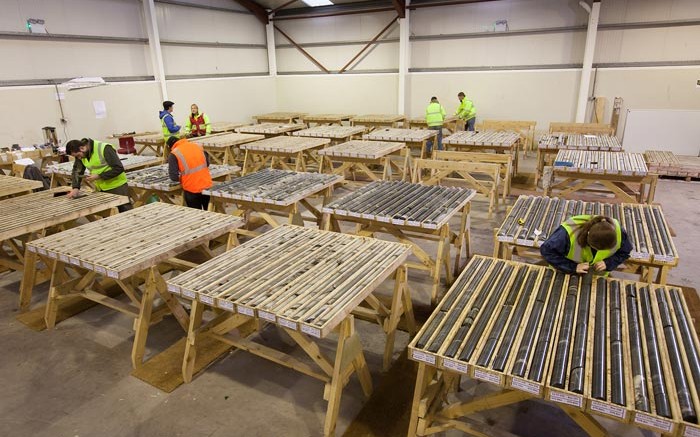Metallurgical test work at the small but high-grade Curraghinalt gold deposit in Northern Ireland suggests that Dalradian Resources (TSX: DNA) can achieve higher recoveries using a sequential gravity flotation circuit rather than whole-ore cyanidation, which informed its preliminary economic assessment (PEA) last year.
More metallurgical work was carried out on a representative composite sample using a sequential gravity flotation circuit and results showed 99.4% gold recoveries, with 29.4% of the gold reporting to the gravity circuit and the rest to a bulk concentrate. This is compared to 91% gold recovery reported in the September 2012 PEA.
The gold-silver development and exploration company said that gold from the gravity concentrate could be processed on-site to produce a saleable doré bar, and the flotation concentrate could either be cyanide leached at the site or sold to a smelter.
Management says that analyzing the flotation concentrate showed the process would produce a clean, saleable concentrate containing no penalty elements.
The test work’s representative composite sample was somewhat higher grade (12.5 grams gold per tonne) than the life-of-mine gold head grade of 8.1 grams gold per tonne, but future work would refine the gravity and flotation circuits over a range of head grades, as well as on preliminary marketing of the concentrates to several smelters to determine potential economic terms.
The Toronto-based junior notes that the tailings from a combined gravity flotation circuit would have a lower sulphide content and would not have been in contact with cyanide, which could make permitting a mining operation there easier.
Dalradian says it expects to have enough material for more metallurgical testing because it applied for planning permission in February to undertake 2,000 metres of underground exploration development, including a 40,000-tonne bulk sample.
“This new alternative processing method would not require cyanide . . . and brings with it the potential for a less complex process, which could simplify permitting,” John Hayes of BMO Capital Markets comments in a research note. “Dalradian’s shares are trading at a 47% discount to our 10% net asset value (NAV) estimate of US$1.44 per share, below emerging producers in BMO Research’s coverage universe, which trade, on average, at a 19% discount.”
The Curraghinalt deposit is a lode gold system made up of structurally controlled, high-grade gold bearing quartz-carbonate veins. It contains measured resources of 0.02 million tonne grading 21.51 grams gold per tonne for 10,000 contained oz., and indicated resources of 1.11 million tonnes averaging 12.84 grams gold for 460,000 contained oz. Inferred resources add another 5.45 million tonnes grading 12.74 grams gold for 2.23 million contained oz.
Curraghinalt consists of at least 10 primary gold-bearing veins, ranging in width from less than 0.5 metre to more than 3 metres, and is open along strike, across strike and at depth. Recent work shows that mineralization continues beyond the boundaries of the current resource model.
The PEA in 2012 envisioned an underground mine that would have an after-tax internal rate of return of 41.9% and a NAV of $467 million, based on an 8% discount rate using a three-year trailing average gold price of US$1,378 per oz. If a five-year trailing average gold price was used of US$1,166 per oz., the NAV would fall to $331 million.
The Curraghinalt project — accessible by several paved highways and local roads — is in the counties of Tyrone and Londonderry, 127 km from Belfast.
According to Dalradian, Northern Ireland “has more geological diversity in 14,000 sq. km than any other place on earth.”
Over the last year Dalradian’s shares on the Toronto Stock Exchange have traded in a range of 48¢ to $1.90 per share. At press time the company was trading at 80¢ per share.
Dalradian has 90 million shares outstanding.


Be the first to comment on "Dalradian seeks to optimize Curraghinalt"